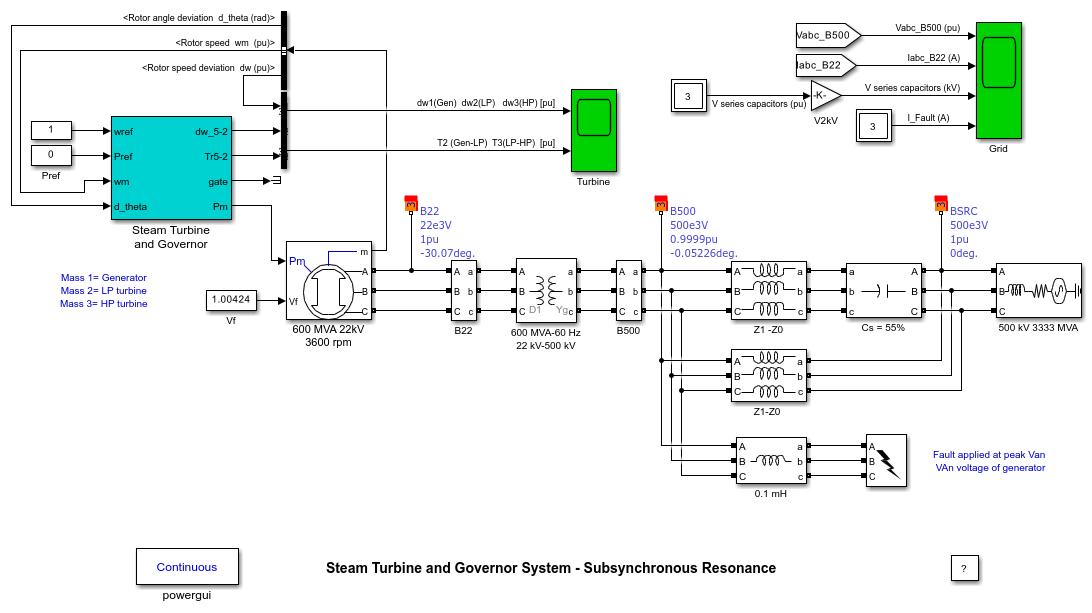Subsyncronous Resonance in Steam Turbine and Governor System
This example shows sub-synchronous resonance (SSR) in Steam Turbine and Governor on a series-compensated network.
R. Champagne and L. Dessaint (Ecole de Technologie Superieure, Montreal)

Description
This system is an IEEE® benchmark [1] used to study sub-synchronous resonance and particularly torque amplification after a fault on a series-compensated power system. It consists in a single generator (600 MVA/22kV/60 Hz/3600 rpm) connected to an infinite bus via two transmission lines, one of which is 55% series-compensated. The sub-synchronous mode introduced by the compensation capacitor after a three-phase fault has been applied and cleared excites the oscillatory torsional modes of the multi-mass shaft and the torque amplification phenomenon can be observed. The mechanical system is modeled by 3-masses : mass 1 = generator; mass 2 = low pressure turbine (LP); mass 3 = high pressure turbine(HP).
Simulation
1. In order to start the simulation in steady-state we initialized the synchronous machine with the 'Machine Initialization' tool. Open the Powergui and select "Machine initialization". The machine "Bus type" should be already initialized as "PV generator", indicating that the initialization will be performed with the machine controlling its active power and terminal voltage. Specify the desired values by entering the following parameters:
*Terminal voltage U AB (Vrms) = 22000, Active power (Watts) = 0 *
Then press the "Compute and Apply" button.
The phasors of AB and BC machine voltages and currents flowing in phases A and B are updated. The SM reactive power, mechanical power and field voltage are displayed : Q = 1.48 Mvar, field voltage Ef = 1.0041 pu; If you open the SM block menu you will observe that the initial conditions have been updated.
2. In order to start the simulation in steady state with the STG connected, this Simulink® block must also be initialized. This initialization is automatically performed as long as you connect at the Pm and Vf inputs of the machine either Constant blocks or regulation blocks from the machine library (HTG, STG, or Excitation System). Open the STG block menu and note that the initial mechanical power and generator rotor angle have been automatically set to Pm0=2.7e-8 pu (corresponding to very low resistive losses in stator windings at zero output active power) and th0 = -120.1 degrees. The Vf constant block connected at the Vf excitation input of the synchronous machine has been automatically set to 1.0046 pu.
3. Open the Scope connected to the STG model. Run the simulation. Observe the speed deviations on the top axis of the Scope and the torques transmitted between the shaft's masses on the bottom axis. A peak torque of over 4 pu is observed for T2 between mass 1 (Generator) and mass 2 (LP turbine). The frequency of the oscillations observed in the torques and speed deviations is about 27 Hz. The peak values we obtained here agree with those given in [1].
Reference
[1] IEEE Sub-synchronous resonance working group, "Second benchmark model for computer simulation of sub-synchronous resonance," IEEE Transactions on Power Apparatus and Systems, vol. PAS-104, no. 5, 1985, pp. 1057-1066.
